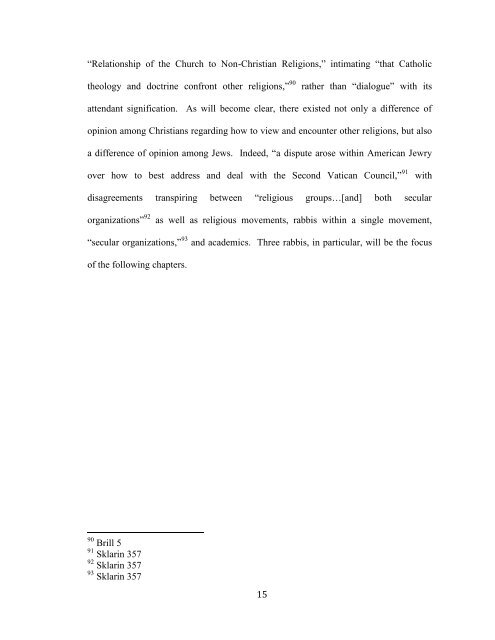The Views of Rabbi Moses Feinstein, Rabbi Abraham Joshua ...
The Views of Rabbi Moses Feinstein, Rabbi Abraham Joshua ... The Views of Rabbi Moses Feinstein, Rabbi Abraham Joshua ...
―Relationship of the Church to Non-Christian Religions,‖ intimating ―that Catholic theology and doctrine confront other religions,‖ 90 rather than ―dialogue‖ with its attendant signification. As will become clear, there existed not only a difference of opinion among Christians regarding how to view and encounter other religions, but also a difference of opinion among Jews. Indeed, ―a dispute arose within American Jewry over how to best address and deal with the Second Vatican Council,‖ 91 with disagreements transpiring between ―religious groups…[and] both secular organizations‖ 92 as well as religious movements, rabbis within a single movement, ―secular organizations,‖ 93 and academics. Three rabbis, in particular, will be the focus of the following chapters. 90 Brill 5 91 Sklarin 357 92 Sklarin 357 93 Sklarin 357 15
Rabbi Moses Feinstein: Biographical Sketch Rabbi Moses Feinstein was widely regarded as one of the most, if not the most, prominent poseqim, or legal decisors, among American Jewry and, arguably, global Jewry ―in the second half of the twentieth century.‖ 94 He was born in Uzdan, in the district of Minsk, Belorussia, where his father served as a rabbi. In 1921, he, himself, became the rabbi of Luban, located in the same district. In 1920, he married Shima Kustanovich, who gave birth to three children in Russia: Faye Gittel, Shifra, and David, as well as one in America: Reuven. In 1937, Feinstein, along with his family, eventually emigrated to the United States, where he taught at the Orthodox Rabbinical Seminary in Cleveland, Ohio ―for a few months‖ 95 before becoming Rosh HaYeshivah of Mesivta Tifereth Jerusalem in New York City. In 1960, he became co-president of the Agudath ha-Rabbanim of America, ―an Orthodox rabbinic organization made up predominantly of European- as opposed to American-trained rabbis‖ 96 and known for its ―policy of nonrecognition of and noncooperation with the American Orthodox rabbinate.‖ 97 In 1962, he became chairman of the American section of the Mo’ezet Gedolei ha-Torah, 94 Telushkin 474 95 Robinson 242 96 Robinson 242 97 Gurock 10 16
- Page 1 and 2: The Views of Rabbi Moses Feinstein,
- Page 3 and 4: TABLE OF CONTENTS 1 Overview: Ecume
- Page 5 and 6: any one denomination to pursue effe
- Page 7 and 8: traditions (‗culture groups‘):
- Page 9 and 10: Leaders, Protestant, Catholic, and
- Page 11 and 12: the national creed.‘‖ 46 Accord
- Page 13 and 14: elationship between the Catholic Ch
- Page 15 and 16: of individuals, such as Roncalli an
- Page 17: authoritarian regimes.‖ 82 In add
- Page 21 and 22: was a Kohen.‖ 102 Through employi
- Page 23 and 24: Rabbi Moses Feinstein on Interfaith
- Page 25 and 26: on Christian-Jewish dialogue, feari
- Page 27 and 28: Joseph B. Soloveitchik, whose own p
- Page 29 and 30: descended from the Beis Halevi (the
- Page 31 and 32: Rabbi Joseph B. Soloveitchik on Int
- Page 33 and 34: certain non-religious matters, shar
- Page 35 and 36: I and Adam II is also found in Solo
- Page 37 and 38: Rabbi Abraham Joshua Heschel on Int
- Page 39 and 40: not only given us rights, it has al
- Page 41 and 42: fratricide,‖ 201 asserting that,
- Page 43 and 44: also is not even an aspiration wort
- Page 45 and 46: theologically than, the tradition o
- Page 47 and 48: for Jews given that this religious
- Page 49 and 50: Bibliography Berenbaum, Michael, an
- Page 51: Sarna, Jonathan D. American Judaism
―Relationship <strong>of</strong> the Church to Non-Christian Religions,‖ intimating ―that Catholic<br />
theology and doctrine confront other religions,‖ 90<br />
rather than ―dialogue‖ with its<br />
attendant signification. As will become clear, there existed not only a difference <strong>of</strong><br />
opinion among Christians regarding how to view and encounter other religions, but also<br />
a difference <strong>of</strong> opinion among Jews. Indeed, ―a dispute arose within American Jewry<br />
over how to best address and deal with the Second Vatican Council,‖ 91<br />
with<br />
disagreements transpiring between ―religious groups…[and] both secular<br />
organizations‖ 92<br />
as well as religious movements, rabbis within a single movement,<br />
―secular organizations,‖ 93 and academics. Three rabbis, in particular, will be the focus<br />
<strong>of</strong> the following chapters.<br />
90 Brill 5<br />
91 Sklarin 357<br />
92 Sklarin 357<br />
93 Sklarin 357<br />
15



